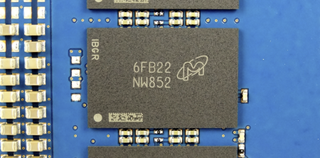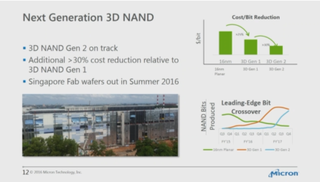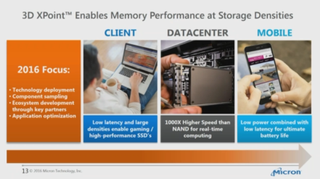Next-Gen Intel, Micron 3D NAND Density Confirmed, 3D XPoint Also Discussed At Nasdaq Conference
Micron's CFO, Ernie Maddock, spoke at the NASDAQ 34th Investor Program in London to outline the company's progress on several fronts, and in the process, he revealed new details about the next generation of the jointly manufactured Intel and Micron IMFT 3D NAND and provided a 3D XPoint update.
Intel/Micron Gen 2 3D NAND - Here Comes Capacity, There Goes Cost
Micron engineers outlined their R&D efforts on a future 3D NAND with increased density at a conference earlier this year, but did not indicate if it would come to market. Maddock confirmed at the NASDAQ conference that its Gen 2 3D NAND will double the density of the current products, confirming that Micron engineers were likely referring to the next-gen NAND.
The current generation of IMFT 3D NAND sports 32 layers, and a single MLC die weighs in at 32 GB (256 Gb), while the TLC die provides 48 GB (384 Gb).
Gen 2 3D NAND will offer up to 64 GB per MLC die and 96 GB per TLC die. Micron did not reveal the number of layers it will employ with the Gen 2 product, but it is a reasonable assumption that it will increase from 32 layers to 64 layers to double the density.

To put this in perspective, NAND vendors can stack up to 16 NAND die in a single package (two-die MX300 package pictured above), so Gen 2 IMFT 3D NAND can cram in 1 TB of MLC NAND per package and up to 1,563 GB (1.5 TB) per TLC package. This increased density will enable beefy storage in mobile applications, such as phones and tablets, and unlock 10 TB 2.5" 7mm SSDs (or 6 TB M.2 SSDs).
Such radical density increases can hamper performance, as SSDs require plenty of parallelism to offer speedy performance. Micron and Intel designed their 3D NAND die with four planes to increase performance in comparison to competing dual-plane designs.

Surprisingly, this amazing amount of storage is right around the corner. First, Maddock revealed that Micron is substantially ahead of schedule with its Gen 1 3D NAND. Micron previously predicted that it would achieve "bit crossover" (the point at which it will ship more 3D NAND bits than 2D NAND) at the end of the year. Micron altered that forecast and indicated that it will achieve crossover ahead of schedule in "the fall of this year."
Stay on the Cutting Edge
Join the experts who read Tom's Hardware for the inside track on enthusiast PC tech news — and have for over 25 years. We'll send breaking news and in-depth reviews of CPUs, GPUs, AI, maker hardware and more straight to your inbox.
Micron projected its Gen 1 3D NAND to reduce cost by 25 percent (in comparison to 16nm planar NAND), but it has yet to reach mass production, so the cost advantages have not trickled down to the market yet. Samsung is the only NAND fab shipping 3D NAND in volume, so when more 3D NAND comes to market it will increase competition, thus pushing the current $0.20-per-GB prices even lower.
Micron has Gen 2 wafers coming already, and it will ramp up production as it moves into 2017. The "leading-edge bit crossover" section of the graphic above indicates that the early stages will ramp in Q1, then increase dramatically in Q2 2017. Maddock also noted that Gen 2 IMFT 3D NAND would reduce cost by 30 percent (relative to Gen 1 3D NAND).
IMFT Gen 2 3D NAND could help to reduce the cost of SSDs into the sub-$0.15-per-GB region when it comes to market, which makes insanely capacious SSDs even more attractive.
3D XPoint Murmurs
Maddock also made broad statements about 3D XPoint, but as per the usual routine, details were slight. Micron expects the new technology to penetrate into the client, datacenter and mobile segments, as illustrated in the graphic below.

Surprisingly, Micron said that it would focus on technology enablement, component sampling and ecosystem development in 2016, which does not engender much faith that we will see Micron 3D XPoint products on the market this year. A "leaked" roadmap is circulating that indicates Intel will ship 3D XPoint-infused Optane SSDs in late Q4 of this year, but the roadmap is either inaccurate or Micron is taking a much more conservative approach.
Maddock commented that the process of building out the ecosystem, controllers and firmware to create a 3D XPoint memory solution is not a rapid process. The specific mention of 3D XPoint as a memory device is important, as it possibly indicates that Micron sees that as the primary vehicle to drive the product to market.
Maddock also commented during the question and answer session that the company expects 3D XPoint to cannibalize a portion of the DRAM market, as opposed to the NAND market. He even went so far as to estimate that 3D XPoint could displace up to 10 percent of DRAM output by the 2019-2020 time frame, but indicated that it is still too early to make accurate predictions. He also mentioned that 3D XPoint is not a ubiquitous replacement for DRAM.
Bring It, Already
Sometimes what isn't said is just as important as what is. 3D XPoint is definitely a hot topic, but Micron's muted non-projections are far more conservative than Intel's publicly stated agenda. Time will tell which company brings the products to market first, but Intel has flaunted its Optane products several times already, which might indicate it has the lead. However, Micron beat Intel to market with their jointly produced 3D NAND, so there may be a surprise in the works.
3D XPoint is going to be more expensive than NAND-based SSDs and will require significant time and support to utilize as memory.
3D NAND, on the other hand, is plug and play at this point. The rapidly shrinking cost and massive density increases will power far more devices in the near term. It will also create more competition between the NAND fabs, which is always a good thing for consumers.
Paul Alcorn is a Contributing Editor for Tom's Hardware, covering Storage. Follow him on Twitter and Google+.

Paul Alcorn is the Managing Editor: News and Emerging Tech for Tom's Hardware US. He also writes news and reviews on CPUs, storage, and enterprise hardware.
-
memadmax And you AMD FanBoys cry wolf all day about how a intel monopoly will cause prices to skyrocket...Reply
Guess what ladies, AMD lost.
Polaris is too little too late, and an embarrassment when placed next to a 1080.
Better hold fast! -
jasonelmore what does any of that crap have to do with a Micro 3d Nand Article? go somewhere elseReply -
LAB MAN MEMADMAX//Reply
Unfortunately, you appear to have no clue: Intel is currently competing with Samsung in NAND business. It has nothing to with AMD first place so let your Nvidia fanboism cool down little bit.
Most Popular

